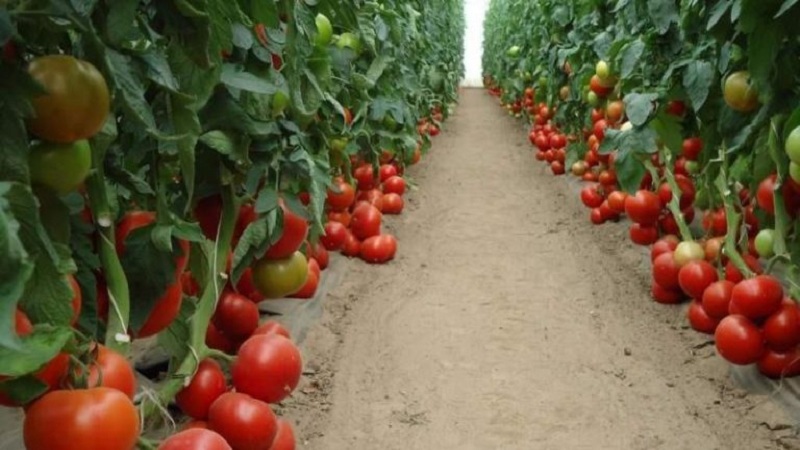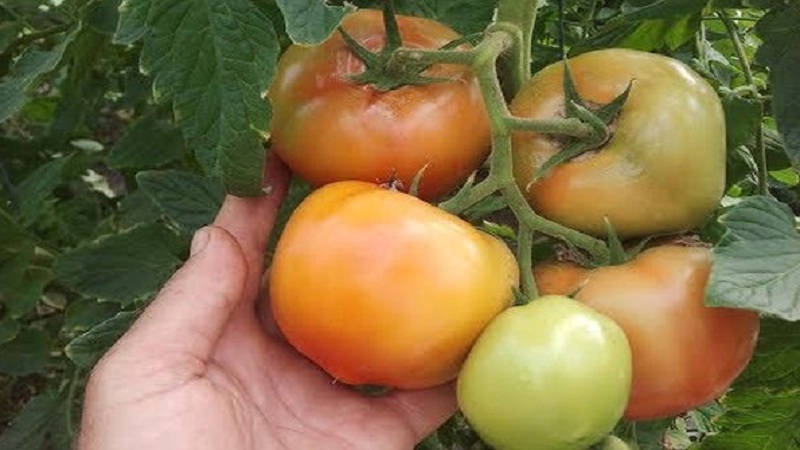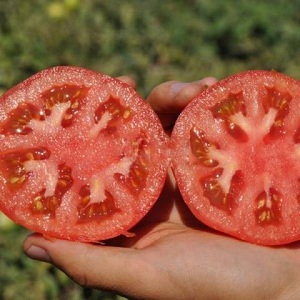Large-fruited Dutch hybrid tomatoes "Mahitos": the secrets of proper care for a bountiful harvest
The Mahitos f1 tomato is a Dutch hybrid that has gained popularity in many countries. It takes root in any climate, is resistant to temperature extremes, high productivity, and the ability to set fruits in stressful conditions.
In this article, we will talk about the advantages and disadvantages of a hybrid, the rules of agricultural technology and fruit collection.
The content of the article
Description of culture
The mid-season tomato Mahitos f1 is bred by the Dutch family business Rijk Zwaan, a recognized leader in the global vegetable breeding market.
The crop is intended for growing in greenhouses. The bushes are indeterminate, they require a garter and formation of 1-2 stems. The plant is densely overgrown with foliage, has a powerful rhizome.
The main advantage of the hybrid is the ability to form ovaries in cold weather and in conditions of sharp changes in the average daily temperature.
In the photo - tomatoes Mahitos f1.

Distinctive features of the hybrid are presented in the table.
| Indicators | Characteristic |
| Weight | 200-300 g |
| The form | Rounded, slightly flattened |
| Fruit color | Red |
| Leaves | Large, green and dark green |
| Inflorescence type | Intermediate |
| Number of nests | 4 to 6 |
| Pulp | Juicy, sweet, high in sugar |
| Taste qualities | Excellent |
| Skin | Smooth, dense |
| Appointment | Universal |
| Bushes height | 1.8-2.5 m |
| Ripening period | 90-100 days after sowing |
| Yield | 5-6 kg / m² or 10 kg per bush |
| Sustainability | To verticillosis, fusarium wilting, cladosporium, tobacco mosaic virus |
| Transportability | High |
Growing seedlings
The Mahitos hybrid is grown through seedlings. Sowing begins 60–65 days before planting in the ground - in late February or early March.
Soil preparation and sowing seeds
Seeds are sown in a light, nutritious substrate... To do this, sod, peat and river sand are mixed in a large bucket in equal proportions. The soil is pre-disinfected with a pink solution of potassium permanganate or heated to 100 ° C in an oven.
The seed does not need disinfection and treatment with growth stimulants, the manufacturer takes care of this. The seed germination rate of Mahitos is close to 100%.
The seedling boxes are filled with moist soil and the seeds are spread to a depth of 1 cm with an interval of 3 cm. A film is stretched on top or glass is placed to create a greenhouse effect. To prevent mold, the soil is aired for 15–20 minutes daily. Seedlings appear at a temperature of +25 ° C in 3-4 days.
Seedling care
The seedlings develop quickly and need nutrition. Before transferring to a permanent place, the plants are fertilized once every two weeks with complex formulations "Agricola", "Fertika", "BioMaster".
A pick into separate containers is carried out after 3-4 true leaves appear. Seven days after this, the first portion of the dressing is added.
A week before planting, the last top dressing is introduced into the ground.
Watering is necessary in moderation, once every 5 days.
Advice... Dip your finger into the soil to check if the soil is dry enough. If the ground is damp, delay watering for 1 to 2 days.
Agrotechnics of tomatoes
Grown up tomato bushes are planted in greenhouses from late April to late May. It all depends on the region, the time of sowing the seeds. In the south it happens earlier, in the north it happens later.
The success of growing a hybrid depends on the frequency of watering and top dressing. In general, the culture is unpretentious, it endures bad weather.
Landing
The soil is prepared in advance:
- in the fall they dig up, bring in a bucket of humus and a glass of wood ash per 1 m²;
- in the spring they are loosened again and disinfected with copper sulfate.
The holes are dug to a depth of 20 cm, a hot solution of potassium permanganate is poured into each and the plants are loaded along with an earthen lump. There are no more than three bushes per 1 m². The landing pattern is 40 × 70 cm.
Care
Water sparingly, once every 7 days. The volume of water depends on the height of the plant, the phase of development, the number of tomatoes. On average, from 3 to 7 liters are poured under each bush. After the formation of the third flower cluster, watering is increased.
After each moistening, the soil requires loosening. To facilitate the task of caring for the beds, the ground is covered with sawdust, hay, straw, pine needles, or a special black agrofibre is used. This stops the growth of weeds, protects plants from bacteria, retains moisture in the soil, and prevents the formation of a crust on the surface.
A tall hybrid is formed into 1-2 stems by pinching... Shoots are cut with garden shears or a sharp knife. The stems are tied to a trellis.
The bushes are fertilized every two weeks with complex compounds, which include nitrogen, potassium, phosphorus, magnesium, zinc. It is advisable to refuse organic dressings due to the large amount of nitrogen in their composition. This leads to a build-up of green mass, or fattening plants. At the same time, the fruits become small, the yield decreases.
Ready-made complexes are ideal for feeding: Agricola, Red Giant, BioHumus, BioMaster. Each package contains instructions for use and dosage.

Features of growing in a greenhouse and garden
Despite the manufacturer's declared ease of growing a hybrid, in practice, farmers face difficulties that depend on the composition of the soil, the frequency glaze and fertilization.
For abundant fruiting, it is recommended:
- use for Mahitos hybrids the areas on which white cabbage, cauliflower, peas, beans, onions previously grew;
- control the level of soil moisture;
- during the formation of ovaries, fertilize the soil with potassium-phosphorus dressingto speed up the ripening of the tomatoes and ensure an even skin color.
The hybrid was originally developed for protected conditions, but in practice it adapts perfectly to open ground. In the southern regions, Mahitos is grown in vegetable gardens. Some farmers do not limit the growing point, but throw the stem over the trellis. Thus, the bushes continue to develop and bear fruit, drooping like a liana. The yield and taste of such tomatoes are somewhat inferior to those planted in greenhouses.
Important! The success of growing a hybrid in unprotected soil depends on the weather conditions. The main thing is that before the cold weather comes, the fruits have time to fill.
Cultivation difficulties

Hybrid Mahitos at the genetic level is predisposed to intensive growth of stems and a set of green mass. If you overfeed the plant or overdo it with moisture, the so-called fattening develops:
- bushes receive unnecessary energy for growth;
- stretches the appearance of ovaries;
- the number of shoots increases.
It's difficult to fix this, so it's better to play it safe:
- Water the planted seedlings moderately - 1 time in 7 days. Increase the water rate after 3-4 brushes are formed.
- If a drip irrigation system is installed in the greenhouse, monitor the rate of each dropper near the bush. It is easier to regulate the water supply from the intensive irrigation belt over time.
- In case of a sharp drop in air temperature, suspend or reduce watering.
- Apply mineral fertilizers only after 3-4 brushes appear.
Sometimes gardeners get fruits with a pale skin and pulp.This happens when the moisture balance in the soil is not observed or there is a deficiency of potassium and manganese. It is recommended to add both minerals at the same time: manganese accelerates the coloring of tomatoes, but without potassium it is not effective.
Hybrid Mahitos is distinguished by its endurance, powerful structure of the bush and withstands climate changes in the greenhouse. This applies to both heat and cold. But to obtain a high yield, the temperature must not be lower than +26 ° C.
Strong foliage is another distinctive characteristic of the "Dutchman". On the one hand, dense foliage allows the plant to cool down, receive oxygen and moisture, on the other hand, excess greens draws juices out of the tomato. The leaves are partially removed: only the lower and sun-protecting fruits.
Diseases and pests
The hybrid has immunity to the tobacco mosaic virus, fusarium, cladosporium, verticillium. But like most tomatoes, it is prone to late blight and insect attacks. Prevention measures help to protect bushes from infection:
- processing greenhouses with sulfur checkers;
- disinfection of soil with copper sulfate;
- mulching the soil with sawdust, hay, agrofibre;
- removal of the lower leaves;
- compliance with the temperature regime;
- moderate watering.
In the fight against late blight, the preparations "Fitosporin", "Ecosil", "Baxis", "Baikal", "Alirin-B", "Quadris", "Gamair", "Antracol" are effective.
Fitoverm, Neoron, Aktellik, Flumite, Epin, Zircon, Aktara, Borneo will help to get rid of aphids, whiteflies and spider mites.
Harvesting and application of the crop
In the northern regions, tomatoes are harvested at the milky, or blange, ripeness stage to increase yields. Early collection increases shelf life and enables transport. After full ripening, the tomatoes retain their presentation and excellent taste for two weeks.
reference... Blange, or brown, ripeness - the stage of technical ripeness, when the inside and on the surface of the fruits become light green with a pinkish tinge. The period of full maturation outside the bushes is 7-10 days.
In the south, Mahitos tomatoes ripen on the bushes. For sale, they are cut with brushes, each of them reaches 1 kg.
Sweet fruits are good fresh and pickled. From overripe, they prepare juice, pasta, sauce, adjika, lecho.
In the first decade of September, the second ripening wave begins. This is the most productive period, the fruits ripen at the same time.
Advantages and disadvantages
Hybrid advantages:
- sweet, juicy pulp;
- high productivity;
- harvesting in two periods;
- adapted to any climatic conditions;
- not susceptible to temperature drop;
- has immunity to nightshade diseases;
- excellent transportability and keeping quality;
- the skin does not crack;
- attractive appearance;
- universal use in cooking;
- the pulp contains the antioxidant lycopene, which prevents the development of oncology.
Disadvantages:
- overripe tomatoes are not transportable;
- if the conditions of care are not followed, the plants begin to fatten;
- sometimes green spots appear on the skin.
Farmers reviews
Mahitos f1 tomatoes have been praised by large farmers and amateur gardeners for their excellent taste, productivity and relative ease of care.
Victoria, Pechory, Pskov region: “The Mahitos hybrid made a splash in our area a few years ago. Raspberry tomatoes flooded the markets, while red ones lost popularity. The situation has changed dramatically with the appearance of the seeds of this hybrid in our market. Tomatoes have an amazing taste, they are suitable for making salads and winter twists. Culture care is not difficult; the main thing is to follow the manufacturer's recommendations - do not overfill or overfill. "
Kirill, Bataysk, Rostov region: “I am engaged in the cultivation of tomatoes for sale. Mahitos is on the favorites list. I plant it in a greenhouse for three years in a row. Last year I planted a few bushes in the garden for the sake of experiment.Culture loves the sun, so in our conditions it is permissible. The technology is the same as in the greenhouse. The yield was lower, but the tomatoes are much tastier, sweeter and the color is even. I know that some farmers feed tomatoes with growth hormones to form a "nose", but I think it's superfluous. The fruits already have an excellent presentation. "
Conclusion
The Mahitos f1 hybrid is valued for its survival in adverse weather conditions, immunity to most tomato diseases (tobacco mosaic virus, fusarium, cladosporium, verticillosis), excellent fruit taste, long shelf life and transportability.
Although the crop was specially created for growing in film greenhouses, it does well in open field conditions in the south of the country. Tomatoes love the sun, moderate watering and fertilizing with potassium-phosphorus fertilizers with manganese.
Compliance with the manufacturer's recommendations for care (watering, fertilizing, removing excess leaves) helps to avoid the build-up of green mass and get a rich harvest.